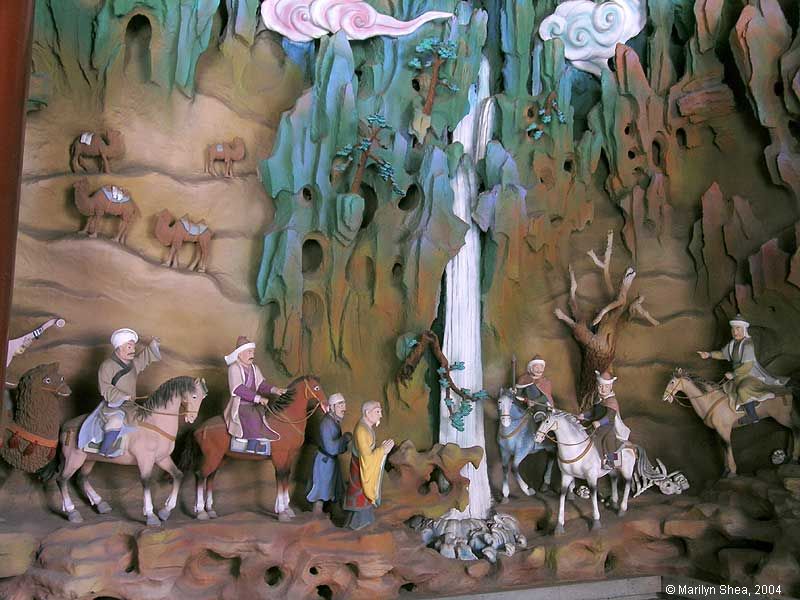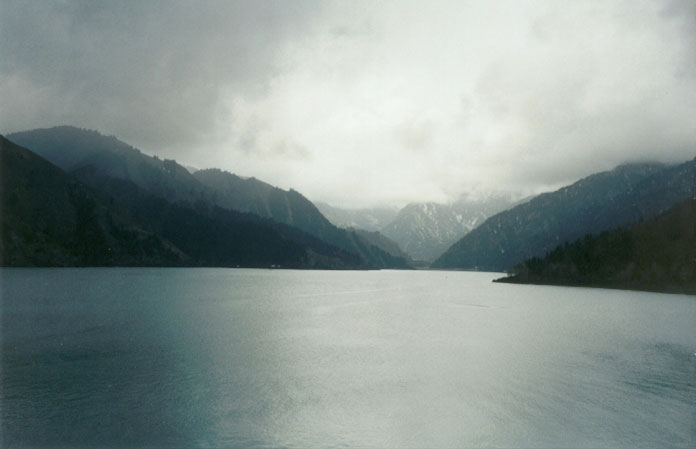On the 27th of the eighth month (September 14), 1221, we arrived at the northern side of the Yin shan. There was a small town (the town of the Hui-ho, spoken of by Chen-hai). The Hui-ho came to meet the master, and the chief of the town presented fruits and Persian linen cloth (Po-sz' pu). He told us that 300 li distant, on the other side of the Yin shan, there was the city of Huo chow; that it was very hot there, and that Huo chou was celebrated for the abundance of grapes.
The next day we proceeded westward along a river, and passed two small towns. At this time (middle of September) wheat was just beginning to get ripe. The land was artificially irrigated by spring-water (conducted from the mountains), for rain is rare there.
Travelling farther to the west, we reached a large city called Bie-sz'-ma. The wang (ruler or prince), the officers, the people, the Buddhist and Taoist priests, &c., came long distances out of the city to meet the master. We lodged in a vineyard west of the city. The relatives of the wang of the Hui-ho brought wine made of grapes, various fruits, &c. The devotion the people felt for the master increased from day to day. In his company were seen Buddhists, Taoists, and Confucionists. The master inquired much about the country and its customs. They told us that at the time of the Tang dynasty (618-907) this city was the tuan fu of Pei t'ing, and that up to this time the frontier towns established by the Tang still exist. They related further, that several hundred li to the east is a fu (city of a department) called Si liang, and 300 li to the west a hien (district city) called Lun t'ai.
The master asked what they reckoned the distance to the place where the emperor (Chinghiz) then was. All agreed in estimating it at 10,000 li and more to the south-west.
On the 2d of the ninth month (September 19) we started again, and after four days' journey westward, stopped east of the city of Lun t'ai, where the chief of the Tie-sie came to meet us.
To the south, on the Yin shan mountains, we saw three rugged peaks supporting the heavens. The master dedicated a long poem to them.
After having passed two towns, we arrived on the 9th of the ninth month (September 26) at a city of the Hui-ho called Ch'ang-ba-la. The wang (ruler, prince) there was a Wei-wu-rh. He was an old friend of Chen hai, and came with his relatives and priests of the Hui-ho to meet us far outside of the city. After our arrival there, he presented us a dinner on a terrace, and his wife regaled us with wine. They brought also very heavy watermelons and sweet melons.
The master received the visit of a Buddhist priest, and spoke with him by means of an interpreter. It must be observed that the country from this place eastward belonged to China at the time of the Tang dynasty. West of it there are neither Buddhists nor Taoists. The Hui-ho [=Muslims] only worship the west.
The next day we proceeded farther to the west, and went along (the northern slope of) the Yin shan as far as about ten stations. We crossed also a sandy desert, where the loose sand is collected by the wind into moving hillocks, resembling the waves of the sea. No vegetation is visible there; the carts cut deeply into the sand, and the horses also sink. To cross this sandy desert took a whole day's journey. This is probably a part of the great desert (which Chen-hai) called the field of white bones. It is bounded to the south by the Yin shan mountains.
After leaving the sandy desert, we travelled five days, and stopped on the northern side of the Yin shan. The next day, early in the morning, we proceeded southward on a long slope seventy or eighty li, and stopped in the evening to rest. The air was cold; we found no water. The next day we started again, and travelled southwest-ward, and at a distance of twenty li suddenly got sight of a splendid lake of about 200 li in circumference, enclosed on all sides by snow-topped peaks, which were reflected in the water. The master named it the Lake of Heaven.
Continued ===>>>
pp. 66-69, E. Bretschneider's Mediæval Researches from Eastern Asiatic Sources. (New York: Barnes & Noble, 1888).

